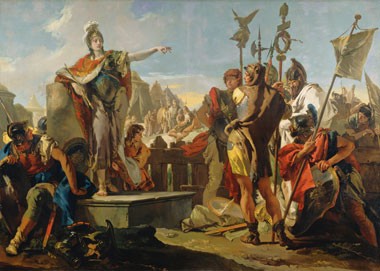Grade Level: 5–6
Students will learn about Queen Zenobia of Palmyra who led her soldiers to challenge the Roman Empire. Then, they will select another famous heroine from history and create a fictional Facebook profile for her as a form of biography. Lastly, they will compose tweets that she would have posted had social media been available in her day.

Giovanni Battista Tiepolo
Italian, 1696–1770
Queen Zenobia Addressing Her Soldiers, 1725/1730
oil on canvas, 261.4 x 365.8 cm (102 15/16 x 144 in.)
National Gallery of Art, Samuel H. Kress Collection
Curriculum Connections
Materials
Warm-Up Questions
What clues does Tiepolo give you in this painting that Zenobia is not an ordinary woman? (She stands on a platform, a servant keeps her robes from touching the ground, she carries a royal scepter.) What is Zenobia doing in this scene? How do the soldiers behave toward her?
Background
Zenobia was queen of Palmyra, in Syria, in the third century A.D. Palmyra was a caravan oasis that had developed into a major economic metropolis of the Near East. After her husband Odenathus was assassinated in A.D. 267, Zenobia assumed power and ruled as regent for her infant son Vaballathus. A shrewd diplomat and military strategist, she challenged the authority of the Roman Empire in the east. She led her troops—an unusual role for a woman in antiquity—to victories in Egypt and Asia Minor. Although Roman power reasserted itself within a few years, her actions changed the empire’s eastern frontier, and she was celebrated for courage and daring.
The military subject of the painting corresponds well with the story of Zenobia, whose exploits in five short years threatened Roman power. The setting is a barren desert, suitable for her homeland in Syria. Her encircling thumb and forefinger have been interpreted as a symbol of unity; before doing battle, Zenobia stands on a dais, which is like a stage or platform, so she can exhort her troops to band together. Her armor shows that she was a brave fighter. Her servant keeps her robes from touching the ground. The staff, or scepter, she carries indicates she is queen.
Tiepolo was one of the most popular Venetian painters of the mid-eighteenth century. His commissions took him to Germany and Spain as well as throughout northeastern Italy. His fame rested on his decorations for princely residences—vast murals and ceiling frescoes—incorporating the best-known episodes from ancient literature. This is one of four large-scale paintings completed for the Zenobio Palace in Venice. Because of the similarity in name, the Zenobio family may have boasted of ancestral connections to Queen Zenobia.
Guided Practice
Activity
Students will select one woman from history that they wish to make a fictional Facebook profile as a form of biography. Some suggested places to get started:
Next, students will fill in the “Facebook" template for their heroine, complete with her career, education, family, likes, and timeline with status updates. Students will also draw two images of their heroine at the top of the template—a cover image and a profile image. They also should create a photo album on the second page of the template by printing and pasting images from the internet.
Extension
Students will then write ten tweets as their heroine, commenting on topics and current events that would be relevant or important to her. Remind them to write in first person and present tense as if she were tweeting today.
VA:Re7.1.6 Identify and interpret works of art or design that reveal how people live around the world and what they value.
VA:Re7.2.6 Analyze ways that visual components and cultural associations suggested by images influence ideas, emotions, and actions.
VA:Re8.1.6 Interpret art by distinguishing between relevant and non-relevant contextual information and analyzing subject matter, characteristics of form and structure, and use of media to identify ideas and mood conveyed.
Borrow the teaching packet Art&
Download or borrow the teaching packet The Inquiring Eye: Classical Mythology in European Art
Research more heroes and heroines—artists, environmentalists, lifesavers, animals, peacemakers, poets, etc.—at the MY HERO Project